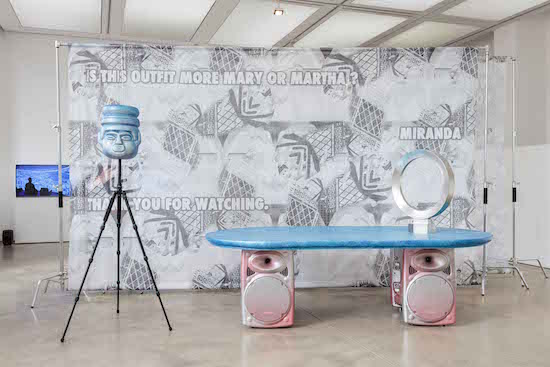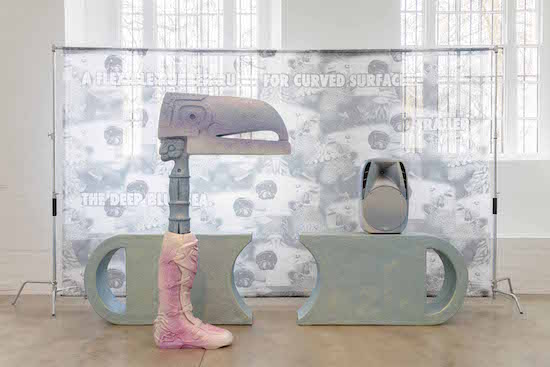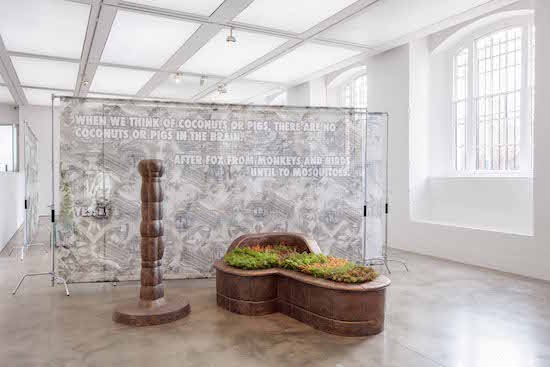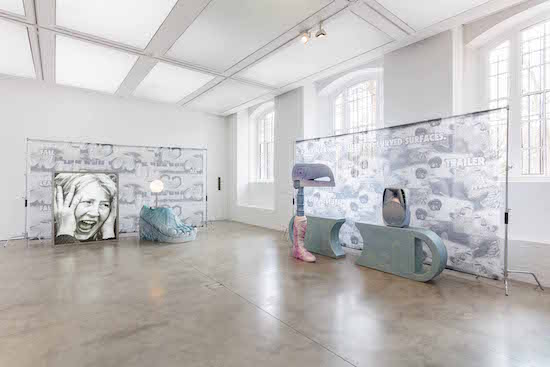There exists a semi-arcane field of at once speculative and strangely necessary research into an entirely new dictionary of symbols. A new mode of visual communication that can most easily be called nuclear semiotics.
Around the world, nuclear waste has been dumped with a toxic half-life that spans so far into the future it’s literally impossible to think about in any meaningful way. Stored, usually deep underground, it occupies cement-lined repositories, in remote areas away from people. Out of sight, out of mind.
The half-life of much of this waste is fully expected to outlast homo sapiens, and probably whatever comes after (homo trans machina?). It will almost certainly outlast everything that currently passes for civilisation and culture. The concern of the nuclear semioticians is how, exactly, we will notify these future hominids about the incredible toxicity to be found in those deep caverns on the coast of Finland, or in New Mexico or wherever. Glowing cats is one suggestion – skull and crossbones another.
The idea that we can divorce symbols from our pre-conditioned ways of reading them – reduce them to something that exists, meaningfully, without any sort of context – is challenging; it’s almost Ballardian. In The Drowned World his characters are driven deep into their lizard brains, into their shared ancestral memory of lava and giant reptiles, by the regression of their environment to the prehistoric. Cultural images are rendered so obsolete in this world that its occupants are forced into a pre-human consciousness of genetically encoded race-memories common to all.
How to visually communicate meaningfully is a question at the heart of Guan Xiao’s current solo show on the ground floor of the ICA. However, her lexicon of symbols goes wilfully undefined. She highlights our methods and processes of engagement by derailing them. As a functioning nuclear semiotic, comprehensible to any earth-bound conscious being, must forgo assumptions about the palette, tools, and sophistication of its audience; so Guan Xiao presents us with images and signs whose collective rightness belies their lack of any obvious or easily-graspable connective logic.

She presents five installations and a film in her exhibition, Flattened Metal. Various texts and interviews have compared her work to puzzles – the process of decoding it akin to solving them. Puzzles themselves are interesting – clues with an objective solution offer a rare moment to share a complete chain-of-thought with another consciousness. Correctly solving them offers a moment of certainty: for the duration of the puzzle, up to its completion, you have thought the same thoughts in the same order with the same conclusion as anyone else who has correctly solved the puzzle. The rest of the time you can second-guess away, but there’s no knowing what reality other people are living.
One of Xiao’s films, David (2013 – and not on display here, although there is a weird bootleg of it available to view on YouTube), presents a collection of images of Michelangelo’s classic, harvested from the internet. The film ostensibly mocks the devaluation of the statue’s image through its mindless and prolific reproduction. More interestingly, though, Xiao calls into question our relationship with the physicality of the familiar and the famous. Discussing the film in an interview, Xiao describes tourists waiting to glimpse David: “They wait a long, long time with a camera and finally go inside. And… that’s all! They don’t know what they want.”
This idea of semi-compulsive behaviour, an audience compelled to witness firsthand something they’ve seen endlessly repeated before, is arguably analogous to the moment of shared experience conferred through the completion of a puzzle. In both, exposure to something, a solution, provide shared moments. In the instance of the puzzle, finding the right answer through the correct logic offers a touchstone to an objective reality. Xiao implies that experience with the physicality of Michelangelo’s David provides the same. A hugely familiar and reproduced image witnessed in the flesh consolidates the atomised experience of millions of minds. Encountering the reality of the sculpture unifies the individual experiences of its image, anchoring the audience together in the world.

Action (2014), the film on show at the ICA, utilises a similar method of production to David – footage harvested from the internet – but rather than underscoring our relationship to image-reproduction in its conferral of objective legitimacy, it presents a very subjective view. Almost a self-portrait, Xiao uses it to attempt to illustrate the workings of her own consciousness.
Image and text are juxtaposed across three horizontally mounted contiguously connected screens, bound together by music with an insistent rhythm that dictates the movement within the films.
Here’s where Xiao assaults our preconceived modes of engagement – where she tries, like the nuclear semiotician, to access an understanding that’s intrinsic, not learned or inculturated. Rhythm, she says, “means all the intersections of sense. It’s a way [she] understand[s] the associations between things.” It’s a connective logic, but sensory, not cerebral.
Onscreen hands clap in time with a beating drum. A goat moves in time with a djembe. Footage from a forgotten performance shows two African American men spitting bars out of sync, until they find each other on the last line: “I am dreaming.”
The challenge, with the film, is watching it without looking for something. The central text element of the film further subverts how we read it: its familiar pseudo-profound text-art content, “Do what you want to,” it says. “Resonate together.”

Searching for narrative where there is nothing to find invites reflection on that same expectation; Xiao shows us not her thoughts but their pattern, distorting the footage with text so that eventually it even loses its linearity. It becomes a whole.
The five installations on show echo this holistic quality. The elements are variable but formulaic. Each one is composed of some combination of faux- antiquity/primitive artefact (that kind of mysterious ancient jungle stuff, like the bits and bobs littered around the Crash Bandicoot landscape – or neo-classical, columns or parts of giant imaginary sculptures) and contemporary readymade (normally those big, ugly plastic speakers that looked futuristic in the early 00’s, although there’s also a tripod).
They’re all set before large, printed screens. Mesh stretched across metal frames, printed with a computer-generated pattern of images (some recognisable, though distorted – bunches of bananas that look almost like intestines, say) in a colour scheme sympathetic to the objects they sit behind. Text printed on the screens is incoherent – like answers from a poorly programmed chatroom AI.
“When we think of coconuts or pigs, there are no coconuts or pigs in the brain.
After fox from monkeys and birds till to mosquitos.
Yes.”

As with Action, these installations frustrate our usual critical logic. The puzzle-like quality of Xiao’s practice is more pronounced, though, in the formulaic combination of objects, words, colours and images.
Breaking them down is no use: whilst individual elements may seem disparate, no single piece can act either synecdochically or metonymically for the whole. Taken in isolation each component is absurd: a large silver light-box holds a print of a woman’s screaming face, hands clasped to the side of her head. She looks out, to her left, towards a large metallic-blue sandalled foot with an art deco globe lamp balanced on it. Elsewhere a Kon Tiki looking tribal head is skewered on the end of a black tripod; a giant beaked, fierce Mayan mask protrudes from a futuristic ski-boot. Together, though, these ridiculous visual elements complement each other. The careful colour schemes provide harmony, while the consistency of the composition conveys a sense of balance.
Each component possesses its own kind of familiarity, finding comparisons in the past and present, but without any specific context. Time is blurred – the faux-tribal or neoclassical offset against the readymade, or digital print, confuses contexts to the extent that they vanish. Time’s perceived linearity is dispensed with and it becomes spatial.
This confusion of colour, form and text is potent with symbolism – but decoding it seems like a fool’s errand. As the rhythmically bound images and text of Action give us a view into the mechanisms of Xiao’s thought processes, so the puzzle-like confusion of imagery in the installations invites us to reflect on our own.
Xiao, in an interview with the Financial Times, asserts that she is “interested in trying to make something that can be understood by any human.” Nuclear semioticians work towards finding a means of universally communicating a specific message to an audience, which, they assume, has no comparable cultural framework with which they can decipher it. Xiao, by contrast, works towards communicating – full stop.
The familiarity of her visual language is enticing, but ultimately frustrates a search for meaning. The syntax of the puzzle promotes the same apprehension of reality as the puzzle itself – the shared moment of objective clarity. But rather than lead us to an answer, she highlights the search. A moment in which, as Action commands, her audience can “resonate together.”
Guan Xiao, Flattened Metal, is at the ICA until 19 June


